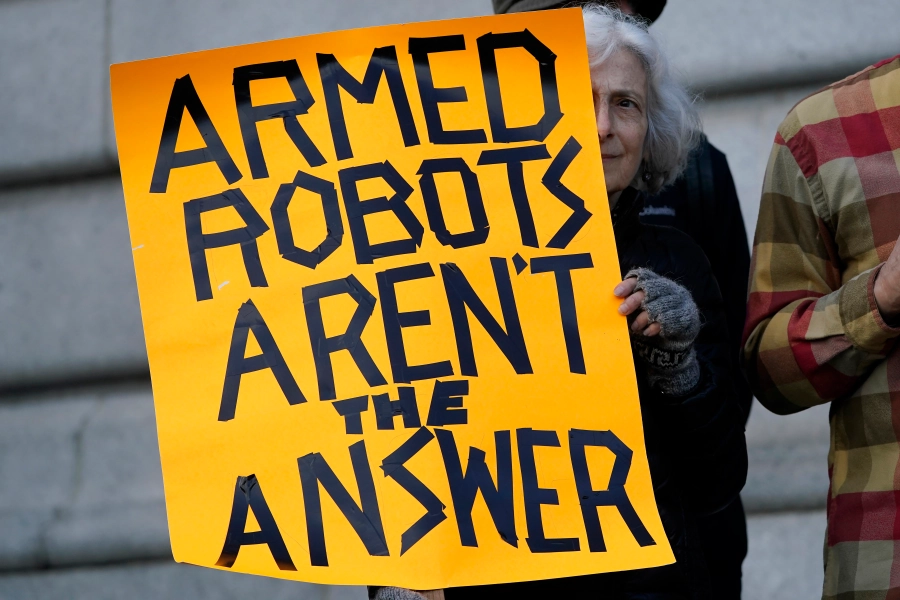San Francisco Reverses Decision for Police Use of Robots
“NO KILLER ROBOTS!” are among the many things the people of San Francisco were shouting since the news of the policy broke.
December 9, 2022
The usage of robots to kill is, oddly enough, not an uncommon practice nor one that doesn’t spark quite a debate. The first time U.S. police officers have used a robot to kill someone was in 2016 during a shooting in Dallas, Texas. Dallas Police Chief, David Brown, stated at the news conference held for what took place that “We saw no other option but to use our bomb robot and place a device on its extension for it to denotate where the suspect was.” The feedback to what occurred was a conjunction of confusion and praise. “Shocking, stunning.” Is what Willard Oliver, a professor of Criminal Justice, labeled the event. “But also very innovative. So I guess in the end, impressive.” This wasn’t the first time bomb robots had ever been used, but takes the first for American police officers choosing to do so.
Along with a mixture of responses, a debate on whether or not police should use robots for deadly force became increasingly popular. Thus, when San Francisco announced on November 29th of this year, they would pass a policy that allows their police officers to do so, an outrage struck. The policy that The San Francisco Board of Supervisors voted to pass states that officers may use ground-based robots to murder “when risk of loss of life to members of the public or officers is imminent and officers cannot subdue the threat after using alternative force options or de-escalation tactics.” These ground-based robots that the policy mentions are ones that the San Francisco Police Department already has access to. Following what the policy was for, the purpose of these robots would be promptly used for bomb disposals, reconnaissance, and rescue operations. Some of these include robots similar to the ones in the Dallas 2016 incident; as the extension of their arms rings familiarity. Contrary to popular belief, these robots written in the policy will be unarmed and strictly remotely piloted, and the San Francisco Police Department has no access to ones that are. However, this didn’t sway most against the policy whatsoever.
Mentioned above, the response from civilians was quite mixed on the announcement of this policy. As there were some supervisors in the San Francisco board meeting that felt the policy was a “necessary move to empower police after several mass shootings across the country.”, the polar opposite was seen in a letter written by the San Francisco Public Defender’s Officer sent to the Board of Supervisors. The letter contained that the policy was “dehumanizing and militaristic.” Some members of the board against the policy chimed in with their personal beliefs, stating that it would “sow distrust within communities and not necessarily save lives.” Board president Shamann Walton also quoted on the matter during the meeting by saying, “…I’m really just stunned we are talking about this.”
‘Killer Robots’ became a quick term coined and spread during these few past weeks. The executive director of the Surveillance Technology Oversight Project stated his worries by telling the Washington Post: “In my knowledge, this would be the first city to take the step of passing a law authorizing killer robots.” This past Monday, December 5th, a protest was held outside of the City Hall – the day before the Board of Supervisors heard the policy for a second vote. At this protest, some people were seen holding signs with ones saying “NO KILLER ROBOTS!” It seemed that the booming voices of the public paid off after all, as on Tuesday the board voted against the policy rather than implement it. Hillary Ronen, supervisor, released a statement regarding the recent vote. “We stopped the use of killer robots in San Francisco today. The public outcry helped six Supervisors fully appreciate the gravity of last week’s vote and the numerous unanswered questions about both the ethics and practical implications of allowing police to use machines to kill human beings.”
“The people of San Francisco have spoken loud and clear: There is no place for killer robots in our city … We should be working on ways to decrease the use of force by local law enforcement, not giving them new tools to kill people.” – Dean Preston, supervisor.


